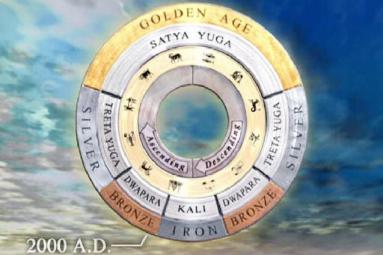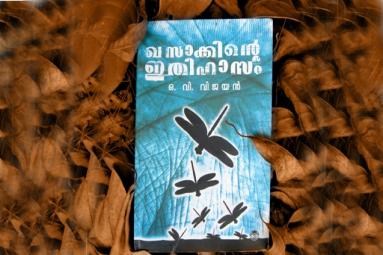
Dvapara Yuga or Dwapara Yuga(Devanagari: द्वापर युग) is the third out of four yugas, or ages, described in the scriptures of Hinduism. This yuga comes after Treta Yuga and before Kali Yuga. According to the Puranas this yuga ended at the moment when Krishna returned to his eternal abode of Vaikuntha. According to the Bhagavata Purana, the Dvapara Yuga lasts 864,000 years.
There are only two pillars left of religion in the Dvapara Yuga: Compassion and Truthfulness. Lord Vishnu assumes the colour yellow and the Vedas are categorized into four parts that is Rig, Sama, Yajur and Atharva. During these times the Brahmins are knowledgeable of two, sometimes three Vedas, but rarely have studied all the four Vedas thoroughly. Accordingly, because of this categorization, different actions and activities come into existence.
All people in the Dvapara Yuga are jealous, valiant, courageous and competitive by nature and are engaged only in penance and charity. They are kingly and pleasure-seeking. In this era, the divine intellect ceases to exist, and it is therefore seldom that anyone is wholly truthful. As a result of this life of deceit, people are plagued by ailments, diseases and various types of desires. After suffering from these ailments, people realize their misdeeds and perform penance. Some also organize Yagya for material benefits as well as for divinity.
Brahmana
In this Yuga, the Brahmanas are involved in Yagya, self-study, donation and teaching activities. They attain celestial bliss by engaging in penance, religion, control of senses and restraint.
Kshatriya
The duties of Kshatriyas are the protection of their subjects. In this era, they are humble and perform their duties by controlling their senses. The Kshatriyas honestly execute all policies of law and order without being angry or cruel. They are devoid of greed and consequently attain bliss.
The king avails the advice of the learned scholars and accordingly maintains law and order in his empire. The king who is addicted to vices will definitely end up defeated. One or two or all from Sāma, Dāna, Danda, Bheda and Upeksha is/are brought into use and help attain the desired. Kings are diligent in maintaining public decorum and order.
A few of the kings, however, surreptitiously plan a conspiracy along with the scholars. Strong people execute work where execution of policies is involved. The king appoints priests, etc. to perform religious activities, economists and ministers to perform monetary activities, impotents to take care of women and cruel men to execute heinous activities.
There are two kshatriya dynasties, namely 'Surya Vansha' and 'Chandra Vansha'.
Vaishya
Vaishyas are mostly landowners and merchants. The duties of Vaishyas are trade and agriculture. Vaishyas attain higher planes through charity and hospitality. Krishna, eighth Avatar of Vishnu was brought up in a Vaishya family though he was a born Kshatriya.
Sudra
The duty of Sudras is to perform tasks that demand highly physical work. Although their form of labour is different from the other three castes, the Sudras are not discriminated against. In fact Vidura, the famous Prime Minister of Hastinapura was born in the Sudra community and attained the status of a Brahmin due to his wisdom, righteousness and learning. All other three sections namely Brahmana, Kshatriya and Vaishya protected Sudras and contributed for their safety and happiness.
source : wikipedia







